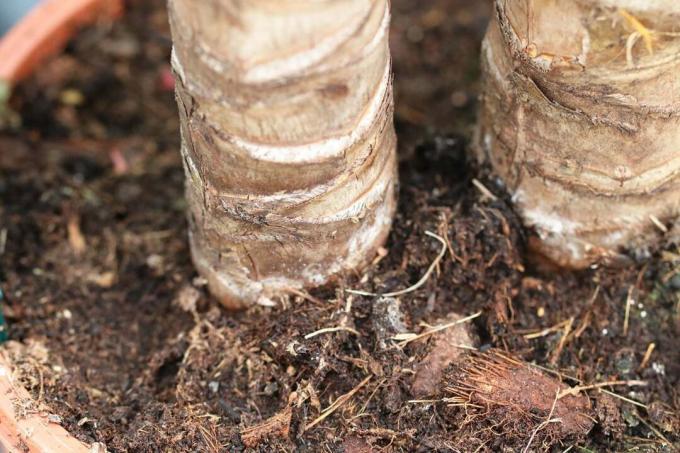
Table of Contents
- Rapid growth
- Growth habit
- Growth influences
- frequently asked Questions
An older one Yucca palm cannot be overlooked due to its imposing appearance. With its growth behavior, it can even manage to touch the ceiling. But how does a yucca palm grow until then?
In a nutshell
- Yucca palm grows quickly
- becomes about 2 to 3 meters high in this country
- Growth retardation if there is a lack of light and nutrients and if the pot is too small
- if there is an urge to grow, reduce fertilizer, repot only every 4 to 5 years and if necessary shorten
- Pointed heads for bushier growth or put several plants in a pot
Rapid growth
This houseplant is mostly called yucca palm (Yucca elephantipes) among plant enthusiasts and in trade, but it is more correctly called Giant palm lily. Not without good reason, because its typical growth behavior makes it not only a beautiful, but also a huge palm under optimal circumstances. Already in the youth it grows quickly, fully grown it can reach the following size:
- up to 10 meters in their home
- in this country their growth is limited by the climate and the pot
- on average 2 to 3 meters in height
- seldom up to 5 m in height in the pot
- in mild regions and with Winter protection it becomes 2-3 m high even with us outdoors
- annual growth very different
- depending on living conditions as well as the initial size and age of the palm

Notice: The leaves of the yucca palm may be sharp-edged. In order to prevent injuries, it is therefore advisable to wear gloves when handling the plant.
Growth habit
Every yucca palm has an individual appearance, because living conditions and light sources influence growth. But the following features are typical for most of the Zimmer specimens of the giant palm lily:
- growing vertically upwards Tribe (s)
- thick, fibrous outside and gray-beige
- brown and often hollow when old
- with numerous, thinner, leafy shoots
- at the ends of them grow tuft-like, radially arranged leaves
- sword-like, soft and green to dark green
- spiked at the end and weakly serrated on the sides
- young leaves protrude upwards
- old leaves are up to 1 meter long and 8 cm wide
- The lowest leaves of a tuft gradually dry up and fall off

Tip: Is your palm growing too fast? if it has already reached a considerable height, you should only repot it every 4-5 years to slow its growth rate.
Growth influences
The living conditions of a palm have a major influence on how quickly and healthily it grows. The main growth drivers are an ideal location and good maintenance.
- airy and bright, preferably full sun place
- from May to October staying outdoors is also good
- permeable soil for container plants
- no soil that is too moist, occasional spraying with water
- Apply green plant fertilizer every 14 days from May to September
- Avoid "one-sided" lighting
- Yucca if necessary rotate

Tip: Lack of light results in thin shoots and sparse vegetation. If the corner of the room is too dark for your Yucca elephantipes, you should definitely install a suitable plant lamp.
frequently asked Questions
If your plant looks healthy, consider the reasons for it being absent. seek retarded growth in their living conditions. It may be too dark, too small a pot or not getting enough nutrients. As soon as the cause is found and eliminated, the growth of the yucca palm changes in a timely manner.
Reduce the amount of fertilizer in good time to slow down the emergence of new leaves. However, you should not stop fertilizing completely, so that there is no insufficient supply. If the palm is already too big, it can be cut with a sharp knife. Incidentally, the cut off part is ideal for propagation. Moving away from the light source is not recommended as a brake on growth. The result would be an increasingly bald plant.
Decapitate your plant in spring. With a little luck, the decapitated trunk will soon drive out more than just a new shoot. You can also plant the cut tip in a large pot with the mother plant.
Only after about ten years of life and under ideal living conditions can the giant palm lily sprout an inflorescence up to one meter high from the tuft of leaves. The countless bell-shaped blossoms in panicles, about 5 cm in size, are reminiscent of lilies of the valley with their shape and white color. In theory, they are edible and are also used in salads, but they contain a lot of saponins.



